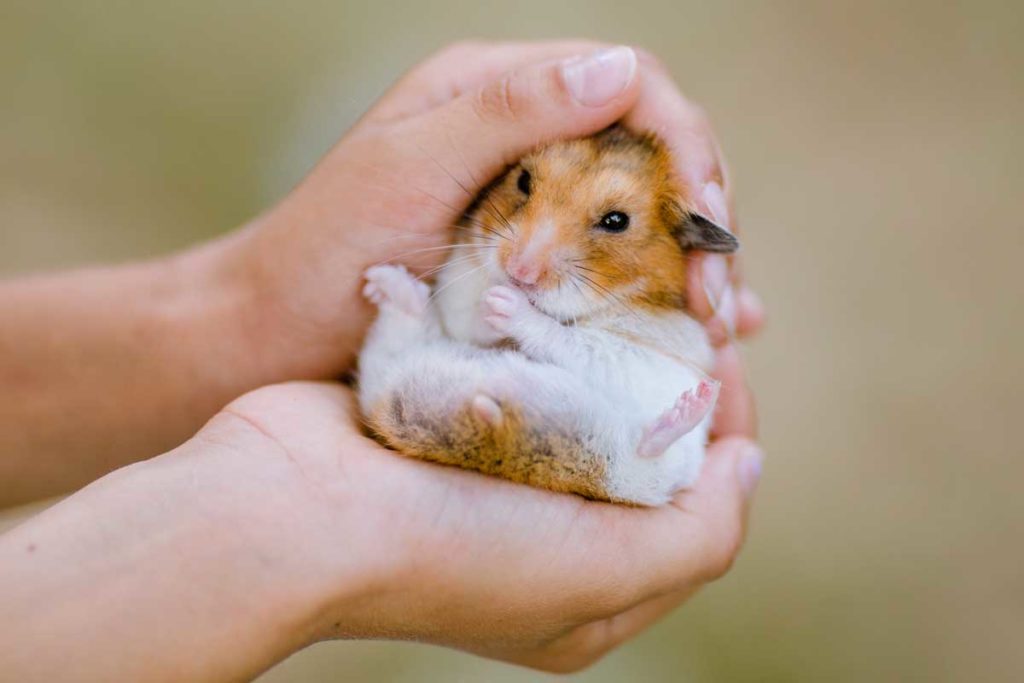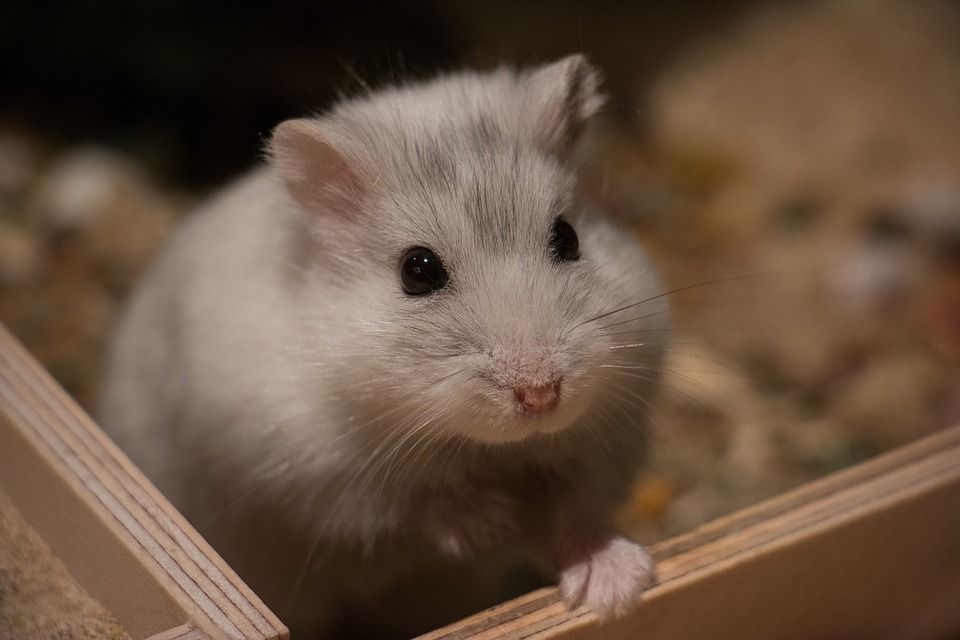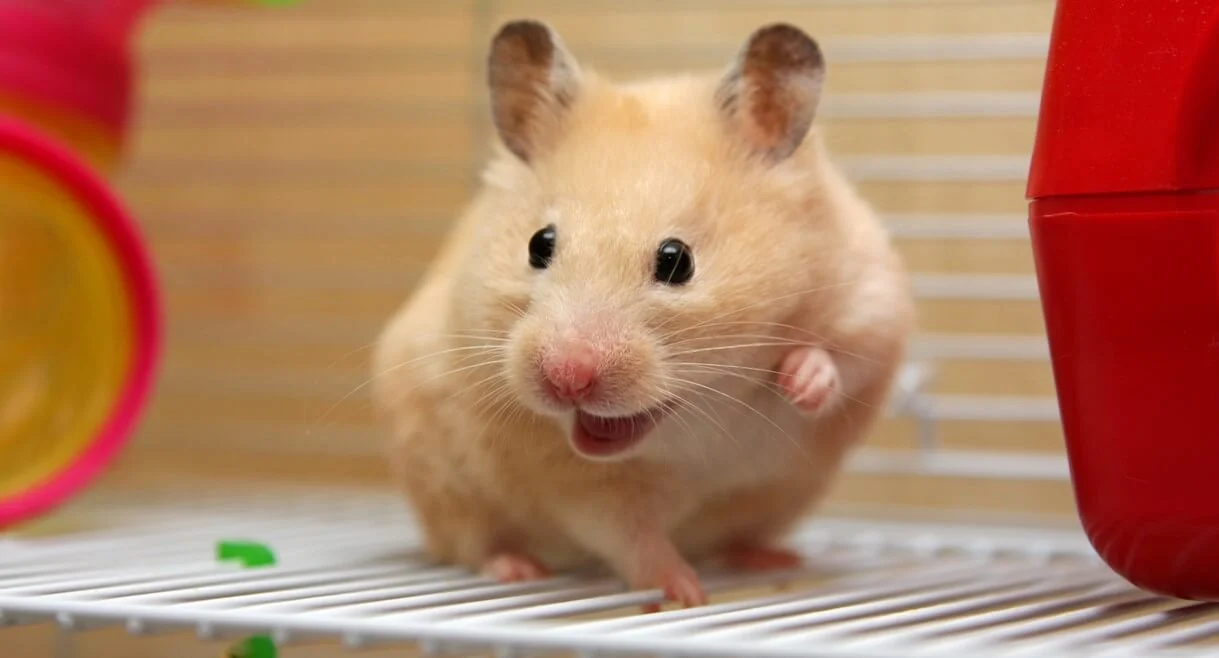Hamsters make an excellent pet for many people.
They are cute and cuddly, prefer not to be noticed, and spend their energy running on their favorite wheel.
Hamsters are one of the most popular first-time pet options. These fluffy cuties are small enough to fit in your hand but not so small that they disappear.
They are usually very friendly and calm, making them ideal pets for younger children learning the ins and outs of pet care.
Hamsters are reasonably priced, but they should be the last item on your shopping list, after a hutch, bedding, toys, a wheel, food, a water bottle, and a food bowl.
The total cost of all of this equipment can be well over a hundred dollars, but if you’re only keeping one hamster, most of it will only need to be purchased once.
You might even have a soft spot for these unconventional rodents and enjoy having them around.
However, if you haven’t owned one in a while, or if this is your first time, one of the most important factors in welcoming one—or two, or more—into your home is the cost.
Let’s break down the cost of owning a hamster so you know exactly how much you’ll be spending. They can make a great pet and are a lot of fun for new pet owners.
We understand that you want more information before deciding whether you can afford a hamster as a pet.
That’s why we’ll go over all of the financial aspects of hamster ownership, from the initial costs to the long-term ones like vet bills and other care.
Reasons Why Hamsters Make Good Pets

They Don’t Need Intense Exercise
Unlike pet dogs, which require hours of intense exercise running outside, hamsters do not. These little buddies, on the other hand, require exercise only once a day.
Regular exercise allows hamsters to fulfill their “scavenger” instinct, which involves running around at night. It also helps with their fitness and health.
Exercise also keeps them active and keeps them from becoming bored, which is undesirable because you do not want a bored hamster.
Bored pet hamsters are known to be irritable, lethargic, and destructive, chewing up almost anything, increasing their chances of escaping.
But don’t worry because there are numerous simple ways to exercise your pet hamster, such as placing a high-quality exercise wheel in its cage, among others.
Hamsters Do Not Require Extensive House Training
Pet hamsters, unlike pet cats and dogs, do not require extensive house training to instill good habits in them.
Potty training your furry little pet will be a breeze because hamsters are naturally intelligent animals that learn quickly.
They are also very clean animals who prefer to eliminate their waste in a single location.
Although hamsters do not need to be taught to sit or perform complicated tricks, socializing your pet hamster with you and other people is essential if you do not want an aggressive biting hamster!
Hamsters Do Not Need A Lot of Attention
Looking for a pet that won’t jump on you the moment you walk in the door?
Hamsters are an excellent choice for this purpose. Hamsters do not typically crave this level of attention.
Your pet hamster will be fine with a clean cage, plenty of food and water, and a high-quality exercise wheel.
That doesn’t mean you should completely ignore your pet.
Giving your pet some love and attention makes it happier and helps it bond and form a relationship with you.
It also makes it easier for your pet hamster to become comfortable around other people.
Hamsters Don’t Take Up a Lot of Space
Hamsters are excellent apartment pets. Pet hamsters don’t take up much space because they spend most of their time inside their cage.
They do, however, require a lot of their own space. And by that, we mean large cages.
Hamsters require large cages with plenty of space for them to run around and satisfy their natural “scavenger” instinct.
They also require enough space to dig and forage to their hearts’ content.
You can also get a cage with tubes, platforms, or ladders for your pet hamster. Furthermore, this will provide a more interesting environment for your pet, resulting in a happy, active pet.
They Require Very Little Maintenance
As previously stated, pet hamsters are naturally clean animals who prefer to empty their bowels in one location, making cleaning up after them a breeze.
They also spend a lot of time inside their cage, so there will be less or no poop for you to clean around the house.
Pet hamsters do not shed, which is an added benefit in terms of upkeep.
Pet hamsters, like cats, are fastidious groomers, which means they constantly clean themselves and don’t require bathing.
However, it is necessary to clean your pet on a regular basis because there are some areas where it cannot clean itself, such as its behind.
What Does a Hamster Cost?
One of the first things to keep in mind as you look for your ideal pet is that hamster prices vary depending on where you shop.
Because they specially breed pedigreed hamsters to meet stringent breed standards, private breeders frequently charge more than the average pet store.
The price is also affected by the hamster’s species.
If you’re looking for a rare breed, it can be pricey.
How much does a pet store hamster cost?
A hamster would cost no more than $15.99 if purchased from a pet store.
This is regardless of size, species, or gender.
You can choose from a variety of hamster breeds, including Russian dwarves, fancy bears, winter whites, short-haired, long-haired, Roborovski dwarves, and Chinese dwarves.
The only hamster that costs a little more is the fancy teddy bear hamster, which is a longhair variety of the Syrian hamster and can cost up to $23.
Petco’s prices aren’t all that different either.
All of their hamsters are $15.99 and include species such as robots (Robowski Hamsters), dwarves, and Djungarian hamsters.
How much does it cost to buy a hamster from a breeder?
There are numerous breeder clubs and organizations. Ethical breeders operate in carefully managed “hamsters” and are frequently a much better place to buy a hamster.
Purchasing from an ethical professional hamster will result in a much healthier, happier, and tamer hamster than purchasing from a store.
We discovered a few locations across the country.
These are not recommendations, so do your research and look for recommendations before purchasing. Their prices are as follows:
- Nantucket Hamstery: $25 in Huntley, IL
- Syrian and dwarf hamsters are $20 each at Holmden Hill Haven in Cleveland, OH.
- Newberg and Wilsonville: $23-$24 for Djungarians, dwarves, and both genders of teddy bear hamsters.
Avoid hamster mills and home breeders.

Please avoid purchasing from “hamster mills,” where female hamsters are relentlessly and irresponsibly bred.
An ethical hamster will never breed a female before the age of four months, and only 3-5 times in her lifetime.
Under horrific conditions, females are bred in hamster mills as soon as they are able to conceive, under horrific conditions until they die.
Some people are unaware of this problem.
If you end up rescuing a hamster from such a situation or purchasing her from a pet store, be a responsible owner and never breed your hamsters!
Because of irresponsible breeding, these hamsters frequently have genetic flaws and should not be bred again.
What Other Fees Are Involved in Hamster Care?
One of the reasons hamsters are so popular as pets are their low cost. (And, yes, they are very cute.)
What you may not consider as you browse Craigslist or visit a pet store are the long-term costs of ownership.
These will end up costing you as much as the hamster – if not more – per month.
According to Investopedia, you’ll spend about $150 per year on necessities such as litter, bedding, and food.
There are also one-time expenses such as supplies, toys, and an enclosure, which could total $160 or more. If you add it all up, you could expect to pay $310 for your first year of hamster ownership.
According to Kiplinger, the first-year cost of ownership is even higher. They estimate that you will spend $345.
After that, you must pay $260 in annual costs, which we will discuss shortly. If your hamster lives for two years, you will spend approximately $605. It costs $865 to enjoy your hamster for three years.
Don’t be misled by these figures.
They may reflect how some people care for their hamsters, but they do not reflect how much good hamster care should cost.
We’ll now go over each area of care that a hamster requires. We’ll give you hard numbers on how much you’ll have to pay monthly and annually to keep your hamster healthy.
Please keep in mind that this post will not attempt to tell you how much other people pay to care for hamsters.
We’ll go over how much good care for a hamster will cost you.
We believe that every pet, including hamsters, deserves the best possible quality of life. And, yes, that high standard of living comes at a cost.
The Cost Of Food and Water For a Hamster

Price of hamster food
The majority of your hamster’s diet should consist of commercial pellets or dry food mixtures that are high in quality and well-balanced.
You’d have to pay, though.
At Walmart or Petsmart, you can readily get low-grade hamster food for as little as $3 per pound.
Don’t If you want to maintain your hamster’s health and activity, you need to buy high-quality food for him or her. And, undoubtedly, the price will go up as a result.
Hamsters eat very little on a daily basis. About two tablespoons, but the amount varies depending on the species. Those hamster pellets should last you for several months at the very least.
There is no need to spend more than $5–$10 a month on this aspect of your hamster’s diet.
The cost of fresh foods
Pellets from a pet store are the primary source of nutrition for your hamster.
Vegetables and fruits can be added to your hamster’s diet because they are omnivores.
Here are a few options that are within reason, along with an idea of what they’ll cost on average.
Using the Produce Price Index, all prices are listed.
- A cantaloupe costs $1.25 per piece of fruit
- a pound of peaches costs $0.64.
- a pound of strawberries costs $1.06
- Price per vegetable: $1.21 for cauliflower
- Broccoli crowns cost $0.75 each.
You can’t take into account the cost of a whole cantaloupe because your hamster won’t eat it all. Cantaloupes don’t last forever, even if they only consume a cup of it.
There isn’t anything that is. In other words, you’ll need to keep buying this product even when your hamster only eats part of a cantaloupe or a cauliflower.
A year’s worth of the aforementioned fruit would cost approximately $255 if purchased weekly for the whole 52 weeks of the year. Naturally, this assumes that the cost of production remains stable.
Only a few fruits and vegetables are available year-round. You’ll pay more for produce if it’s out of season. As a result, you’ll receive a better deal on fruit while it’s in season.
Food dishes and water bottle
Feeding your hamsters, which includes the purchase of food dishes and water bottles, is also an initial expense.
If you want to avoid your hamster chewing on or otherwise ruining your porcelain food dish, it’s well worth the investment.
The following is what you’ll pay for food and water when you first get a hamster. (This includes all of the vegetables and fruits listed above, as well as pellets. A maximum of $50 to $60.)
Your food costs per month (assuming you buy one bag of pellets per month and a variety of fruits and vegetables above) will be the following: $40-$50.
The cost of toys for your hamster
Toys for hamsters are a great way to provide your pet with both stimulation and exercise. The exercise ball is probably the first toy you think of when you think of hamsters.
Many hamsters aren’t going to enjoy this because they’ll be unable to engage with their environment while they’re bouncing around in circles.
You’d be better off getting the following instead:
- Exercise wheels
- Slides
- Tube mazes
- Chew toys
These “toys” are crucial to your hamster’s well-being.
Your hamster’s way of simulating running is through the use of exercise wheels.
Every night, Syrian hamsters can run for miles and miles in the wild. Make sure your hamster has a wonderful wheel to run on!
Slides and tube mazes provide a purpose beyond simple entertainment. They expand your hamster’s living space, allowing him to wander about and explore within the constraints of his cage.
The more you spend on a high-quality tubing system, the more room you’re generating for your hamstrings.
Chew toys are critical to the dental health of your hamster. These teeth will become overly long if they aren’t chewed on.
It will cost much more to have these teeth filed down by your veterinarian.
The best thing to do is to invest in high-quality chewing toys and replace them as needed. In addition to being excellent for your hamster’s teeth, it’s also beneficial to their mental health.
Quality toys are worth the extra money now.
A replacement will be required if the cheap ones break. You don’t want your hamster getting hurt, which would necessitate a trip to the vet, which we’ll discuss in more detail later.
By purchasing a subpar toy, you run the risk of spending more money than you would have otherwise.
We’re looking at an initial investment of $30-$70 for a hamster.
Expect to spend an additional $10 a month on chew toys that need to be replaced after that.
Consider making some of your own toys. A hamster slide or even a full playground can be made out of wood or plastic if you’re really skilled at working with these materials.
To get started, there are numerous tutorials available online.
You may also give your hamster empty toilet paper and paper towel tubes as toys. If you’re having difficulty affording hamster care, these are some excellent options.
Cost of Veterinary Care For a hamster
We’ve reached the biggest budget item.
Since hamsters are small, it doesn’t cost much to feed and play with them.
But there are no discounts for size when it comes to veterinary care. In fact, it’s the other way around.
At least for some problems, you’ll need a specialist, so expect vet care to be more expensive.
Some experts say that you should take your hamster to the vet once a year for a simple checkup.
Many caring owners only take their hamsters to the vet when they see that something is wrong. And that will happen to every hamster at some point in their life.
Even though you don’t have to pay for vaccinations, if your hamster seems sick or hurt, you have to take it to the vet.
Here are some signs that your hamster might be sick and needs care:
- Lethargy and weakness
- Moodiness
- Unwilling to play, run, or interact
- May eat less if at all
- Seizures
- Diarrhea
- Dull and/or sunken eyes
- A runny nose
- Loss of fur and/or dandruff
- Skin irritation
Some vet clinics do not treat hamsters, but you can take a cat or dog to any vet. Most people think of them as “exotic” animals, so you need a vet who specializes in them.
It’s best to find a vet in your area who can treat your hamster before it gets hurt or sick. So, if your hamster ever needs help right away, you can get it right away.
The Hamster Hideout forum says that antibiotics for conditions like wet tails can cost anywhere from $10 to $20.
Hamster surgery could cost $75 or more. It’s not crazy to spend $200 to $300 on surgery for your pet. In fact, one person wrote that they had to pay $150 for a biopsy and medicine.
Checkups could cost you at least $70. Some injections can cost around $100 or more. If your hamster needs urgent care, you might have to pay $117 for the appointment.
Even though no one wants to think about it, euthanasia may cost more than $200 if your hamster dies. A cremation could add $200 to the cost.
If your hamster is in pretty good health, the average cost of vet care for one year is between $100 and $250.
Total Costs of Caring for a Hamster
Ok, let’s go over everything and figure out how much it should cost to take care of a hamster properly.
Initial costs
This is how much you will have to pay for the hamster, its cage, and some basic supplies.
- Buying a hamster from a good breeder costs $25.
- A good-sized cage costs $70.
- $20 plate for food and a bottle of water
- $50 for a hamster wheel/saucer and a tube maze
- The total cost will be $165.
Annual costs
You’ll also have to pay for the following things on a regular basis.
- $100 worth of good dry food
- $100 worth of fresh food
- $200 cage bedding
- $10 toys to chew
- $200 for veterinary care
- The total budget for the year is $610.
This means that the first year of taking care of a new pet hamster will cost you a total of $775, and every year after that will cost you $610. Or about $50 every month.
List of Hamster Care Supplies and Cost
Each time you buy these supplies, you can expect to pay:
| Bedding | $10 |
| Wheel | $10 |
| Toys | $2-$20 |
| Exercise Ball | $6-$14 |
| Water Bottle | $5-$20 |
| Food Dish | $2-$8 |
| Cage | $10-$50 |
| Food | $5-$10 |
Conclusion
You can now see just how much money you’ll have to put aside for your new best pal.
After the initial purchase, costs drop dramatically.
After the first $120 investment, monthly expenditures will range from $30 to $40.
You could spend upwards of $600 a year on veterinary care and related fees.
To sum it up: hamsters are not always inexpensive. Taking care of one can be expensive, but it’s well worth the investment.






